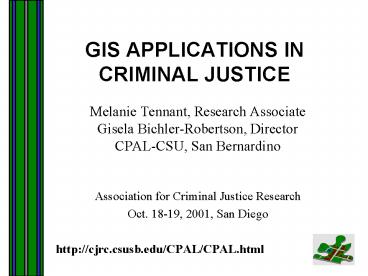GIS APPLICATIONS IN CRIMINAL JUSTICE - PowerPoint PPT Presentation
1 / 26
Title:
GIS APPLICATIONS IN CRIMINAL JUSTICE
Description:
Identify unusual activity levels by time or location ... crime scene, psychological & forensic information. link serial or related events ... – PowerPoint PPT presentation
Number of Views:56
Avg rating:3.0/5.0
Title: GIS APPLICATIONS IN CRIMINAL JUSTICE
1
GIS APPLICATIONS IN CRIMINAL JUSTICE
- Melanie Tennant, Research Associate
- Gisela Bichler-Robertson, Director
- CPAL-CSU, San Bernardino
- Association for Criminal Justice Research
- Oct. 18-19, 2001, San Diego
- http//cjrc.csusb.edu/CPAL/CPAL.html
2
I. What is GIS?
- Geographic spatial realities
- Information data and their meaning
- System computer technology
3
The GIS Funnel
- Source Davis, B., (1996). GIS a Visual Approach.
Onward Press. Pg. 26.
4
GIS Analysis
- Techniques using maps to explore data and
identify patterns. - Pin Maps
- Cloropleth or Thematic Maps
- Density Maps
5
Current GIS Applications inCriminal Justice
- Law Enforcement
- Arson Investigation
- Border Patrol
- Police Departments
- Courts
- Corrections
- Probation/Parole
6
II. Police Use of GIS
- Augment Traditional Functions
- Crime Analysis
- Information Dissemination
- Enhance Problem Solving
- Community and Problem-oriented Policing
- Task Forces
7
Enhancing Traditional Crime Analysis
- Strategic
- Identify unusual activity levels by time or
location - Forecast potential crime events/ concentration
8
Source Bueermann, J. (1999). Mapping for
Managers. CMRC 10th Annual Conference.
9
- Tactical
- Day to day
- For series, patterns, sprees, hot spots
- Used for Deployment Administration
10
Source Bueermann, J. (1999). Mapping for
Managers. CMRC 10th Annual Conference.
11
- Investigative
- crime scene, psychological forensic information
- link serial or related events
- Temporal, geographic, DAN evidence to develop
trends
12
Source Rossmo, 1999. Figure 6.1. In K. Harries.
Mapping CrimePrinciple and Practice. NIJ.P.153
13
- Intelligence
- linkage between crime organizations enterprises
- Relate elements such as companies, agencies,
people, times, days, to crimes places
14
(No Transcript)
15
(No Transcript)
16
- Operations
- Assess needs (calls for service, population of
data demographics) - Generate projections for deployment resource
allocation
17
Source Hayes, (2001). Patrol Deployment/
Redistricting IACA Training Conference, Long
Beach Sept. 20th 2001.
18
- Academic or Administrative
- reports or statistical summaries for grant
funding, commanders public - Policy implications beyond law enforcement
19
Source Bueermann, J. (1999). Mapping for
Managers. CMRC 10th Annual Conference.
20
III. Challenges to Using GIS
- Ethical Issues
- Redlining
- Privacy Issues/Liability
- Technological limitations
- Learning curve
- Data Compatibility (format)
- Data Limitations
- Large scales/ detail of basemaps
- Availability and Currency
- Lack of micro-level data
21
Making Data Mapping Available to the Community
- Advantages
- Public awareness
- Partnerships
- Involvement/ Empowerment
- Accountability
- Disadvantages
- Privacy
- Commercialization
- Redlining
- Insurance rates
- Misinterpretation
22
- There are some important things that you needto
know about before using this data! - ALL ASPECTS OF THE DATA PROVIDED HEREIN ARE
SUSCEPTIBLE TO A DEGREE OF ERROR DUE TO THE
COMPLEXITIES OF THE PROCESS INVOLVED IN COMPILING
AND PROGRAMMING THE DATA. NO WARRANTY,
REPRESENTATION OR GUARANTY IS MADE OR IMPLIED
REGARDING THE CONTENT, SEQUENCE, ACCURACY,
TIMELINESS OR COMPLETENESS OF THE DATA PROVIDED
HEREIN. - THIS VISUAL PRESENTATION OF DATA IS BEING
PROVIDED STRICTLY AS A COURTESY, AND NOT AS AN
OBLIGATION, TO ITS READERS. THE POLICE DEPARTMENT
DOES NOT HAVE STAFF AVAILABLE TO ASSIST IN THE
INTERPRETATION OF THE DATA PRESENTED HEREIN - I have read and understand the above Continue I
do not wish to continue Back to main menu - Sacramento Police Department http//citymaps.sacto
.org/GISAPPS2/cdisclaimer.htm
23
Data Limitations impact Problem Solving
- Lack of micro-level data in digital form
- Aggregation of community information
- Place Intensive Research
LEADS TO
24
- Place Intensive Methods
- Resource limitations
- Scale boundaries
- Lost community context
- GIS Analysis
- Aggregated information
- Large scale analysis
- Data and technological limitations
SOLUTION
Blended Approach
25
Blended Approach
- Phase 1. Community-level Analysis
- Crime Analysis provides a framework and focus.
- Phase 2. Contextual-level Analysis
- Abbreviated User Analysis identifies micro,
community level attributes that influence crime.
26
Copies of this Presentation are available from
- Crime Prevention Analysis Lab
- California State University
- San Bernardino
- cjrc.csusb.edu/CPAL/CPAL.html































